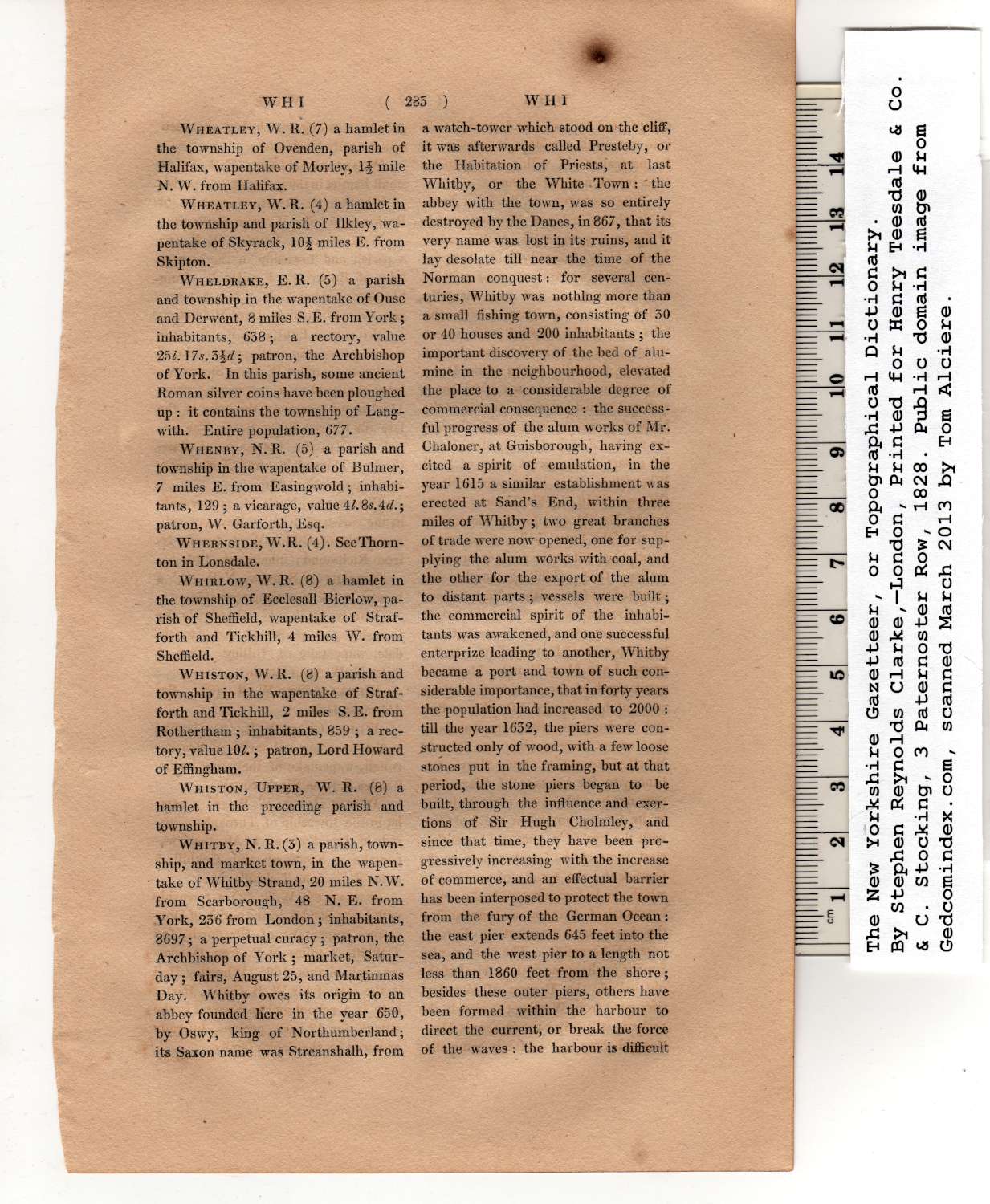|
Wheatley, W. R. (7) a hamlet in
the township of Ovenden, parish of
Halifax, wapentake of Morley, 1^ mile
N. W. from Halifax.
Wheatley, W. R. (4) a hamlet in
the township and parish of Ilkley, wa-
pentake of Skyrack, 10§ miles E. from
Skipton.
Wheldrake, E. R. (5) a parish
and township in the wapentake of Ouse
and Derwent, 8 miles S. E. from York;
inhabitants, 638; a rectory, value
25/. 17-s. 3§t/; patron, the Archbishop
of York. In this parish, some ancient
Roman silver coins have been ploughed
up : it contains the township of Lang-
with. Entire population, 677.
Whenby, N. R. (5) a parish and
township in the wapentake of Bulmer,
7 miles E. from Easingwold; inhabi-
tants, 129; a vicarage, value 4/. 8s. 4*/.;
patron, W. Garforth, Esq.
Whernside, W.R. (4). See Thorn-
ton in Lonsdale.
Whirlow, W. R. (8) a hamlet in
the township of Ecclesall Bierlow, pa-
rish of Sheffield, wapentake of Straf-
forth and Tickhill, 4 miles W. from
Sheffield.
Whiston, W. R. (8) a parish and
township in the wapentake of Straf-
forth and Tickhill, 2 miles S. E. from
Rothertham ; inhabitants, 859 ; a rec-
tory, value 10/.; patron, Lord Howard
of Effingham.
Whiston, Upper, W. R. (8) a
hamlet in the preceding parish and
township. |
Whitby, N. R. (3) a parish, town-
ship, and market town, in the wapen-
take of Whitby Strand, 20 miles N.W.
from Scarborough, 48 N. E. from
York, 236 from London; inhabitants,
8697; a perpetual curacy; patron, the
Archbishop of York ; market, Satur-
day ; fairs, August 25, and Martinmas
Day. Whitby owes its origin to an
abbey founded liere in the year 650,
by Oswy, king of Northumberland;
its Saxon name was Streanshalh, from
a watch-tower which stood on the cliff,
it was afterwards called Presteby, or
the Habitation of Priests, at last
Whitby, or the White Town: the
abbey with the town, was so entirely
destroyed by the Danes, in 867, that its
very name was lost in its ruins, and it
lay desolate till near the time of the
Norman conquest: for several cen-
turies, Whitby was nothing more than
a small fishing town, consisting of 30
or 40 houses and 200 inhabitants ; the
important discovery of the bed of alu-
mine in the neighbourhood, elevated
the place to a considerable degree of
commercial consequence : the success-
ful progress of the alum works of Mr.
Chaloner, at Guisborough, having ex-
cited a spirit of emulation, in the
year 1615 a similar establishment was
erected at Sand’s End, within three
miles of Whitby; two great branches
of trade were now opened, one for sup-
plying the alum works with coal, and
the other for the export of the alum
to distant parts; vessels were built;
the commercial spirit of the inhabi-
tants was awakened, and one successful
enterprize leading to another, Whitby
became a port and town of such con-
siderable importance, that in forty years
the population had increased to 2000 :
till the year 1632, the piers were con-
structed only of wood, with a few loose
stones put in the framing, but at that
period, the stone piers began to be
built, through the influence and exer-
tions of Sir Hugh Cholmley, and
since that time, they have been pro-
gressively increasing with the increase
of commerce, and an effectual barrier
has been interposed to protect the town
from the fury of the German Ocean :
the east pier extends 645 feet into the
sea, and the west pier to a length not
less than 1860 feet from the shore;
besides these outer piers, others have
been formed within the harbour to
direct the current, or break the force
of the waves : the harbour is difficult |
